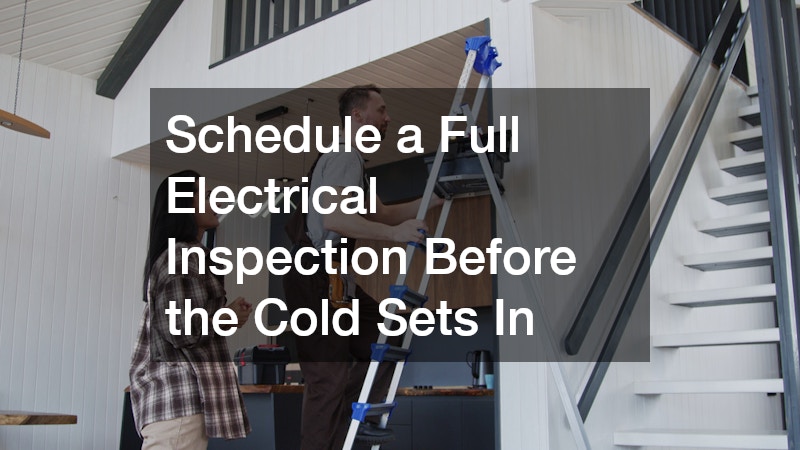As the temperature begins to dip and the days grow shorter, homeowners across the country start thinking about how to prepare their properties for the challenges that cold weather brings. Winter can be both beautiful and brutal—blanketing your surroundings in snow while simultaneously testing every corner of your home’s structure and systems. From frozen pipes to drafty windows, the cold season has a way of revealing hidden weaknesses. Taking time to properly prepare your home now can save you from costly repairs and uncomfortable surprises later.
Getting your home ready for the winter isn’t just about comfort; it’s about safety, efficiency, and long-term protection of your investment. Cold weather, moisture, and fluctuating temperatures can cause structural stress and wear on key systems like your roof, plumbing, and HVAC. A few proactive steps in the fall can make all the difference when the first freeze hits.
Explore ten essential areas of your home that deserve your attention before the snow starts to fall. From inspecting your roof and sealing out moisture to maintaining your heating system and backup generator, each section will walk you through practical steps to make sure your home is warm, dry, and energy-efficient all season long. Whether you live in a mild or snowy climate, these tips will help you prepare for the winter with confidence so you can focus on enjoying the cozy side of the season instead of worrying about what might go wrong.
Inspect and Protect Your Roof Before Cold Weather Hits
Your roof is your first line of defense against the harsh conditions that come for the winter, so it’s essential to inspect and maintain it before the cold sets in. A damaged or aging roof can lead to leaks, ice dams, and costly water infiltration once the snow begins to melt. Begin by visually examining your shingles for any signs of curling, cracking, or missing pieces. Pay attention to flashing around chimneys, vents, and skylights, as these areas are especially prone to leaks.
If you notice anything concerning or simply want peace of mind, it’s wise to contact residential roofing contractors for a professional inspection. Experienced contractors can identify hidden issues such as weak spots, clogged gutters, or compromised underlayment that could worsen under heavy snow. They’ll also ensure that your attic ventilation is working properly, preventing ice buildup and heat loss.
Addressing roofing issues now can save you from emergency repairs when snow and freezing temperatures make roof work much more complicated. Taking these precautions ensures that your home stays dry and insulated from the top down—providing comfort and confidence throughout the colder months.
Seal Out Moisture to Prevent Costly Winter Damage
Moisture is one of the biggest threats to your home during the colder months. When rain and snow accumulate and then freeze, they can expand cracks in your foundation, damage masonry, and lead to water seepage inside your home. Preparing your property for the winter means taking proactive steps to keep moisture out where it belongs.
A local waterproofing service can be invaluable at this stage. Professionals can assess your basement, crawl spaces, and foundation for vulnerabilities that may not be obvious to the untrained eye. They may recommend sealing walls, installing sump pumps, or improving drainage systems around your property to divert water away from your home.
Additionally, check exterior caulking around doors and windows, and ensure that your gutters and downspouts are clean and properly directing runoff. By addressing potential moisture issues early, you’ll prevent water-related damage, mold growth, and structural deterioration—giving your home a solid, dry foundation all season long.

Upgrade Drafty Windows to Keep the Warmth Inside
Few things make a home feel colder than drafty windows. If you find yourself layering up indoors, it might be time to evaluate your windows before temperatures drop for the winter. Old or poorly sealed windows allow warm air to escape and cold air to enter, forcing your heating system to work overtime. This not only makes your home less comfortable but also drives up your energy bills.
Consider working with a window replacement service to assess your current windows’ efficiency. Modern energy-efficient windows use multiple panes, insulated frames, and advanced coatings that help retain heat while reducing outside noise. Installing or upgrading to these windows can dramatically improve indoor comfort and lower heating costs.
If full replacement isn’t feasible, you can still take temporary steps such as applying weatherstripping, using window insulation film, or adding heavy curtains to help reduce heat loss. No matter which approach you choose, ensuring your windows are well-sealed will make a noticeable difference once the cold sets in.
Ensure Smooth Operation of Your Garage Entry Systems
Your garage plays a larger role in your home’s insulation and convenience than many people realize. When preparing for the winter, take time to inspect your garage door and its components. Cold weather can cause metal parts to contract, lubricants to thicken, and seals to become brittle—all of which may interfere with smooth operation or even cause the door to stick.
Scheduling garage door repairs before freezing temperatures arrive ensures your system will function reliably all winter long. A technician can check the springs, cables, and tracks for wear, apply the right type of lubricant for low temperatures, and replace worn weather seals to keep out cold drafts and moisture.
A properly maintained garage door also prevents heat loss, especially if your garage is attached to your home. Keeping this often-overlooked area insulated helps maintain indoor warmth, protect stored items, and reduce strain on your heating system during the cold months.

Check Your Heating System for Maximum Efficiency
When preparing your home for the winter, your heating system deserves special attention. A well-maintained furnace or heat pump not only ensures comfort but also saves money on energy costs. Before the first cold snap, schedule a professional inspection from an HVAC company to clean and tune up your system.
Technicians will check components like filters, burners, and thermostats to make sure everything is running efficiently. They can also detect potential issues—such as carbon monoxide leaks or failing parts—before they turn into emergencies. If you have a programmable thermostat, make sure it’s set for optimal efficiency by lowering the temperature slightly at night or while you’re away.
In addition to professional maintenance, remember to replace air filters every one to three months during heavy use. These small steps help keep your system in top condition, ensuring your home stays warm, safe, and efficient all winter long.
Secure Your Electrical Grounding for Winter Safety
Electrical safety is often overlooked during home winterization, but it’s essential to check your systems before the cold weather arrives. Freezing temperatures, ice, and moisture can increase the risk of electrical malfunctions. Before preparing your home for the winter, confirm that your electrical system is properly grounded.
Properly installed grounding rods protect your home by channeling excess electricity safely into the ground, preventing power surges and reducing the risk of electrical fires. Over time, these rods can corrode or loosen, especially in regions with high soil moisture or frequent freezing and thawing cycles.
Have a licensed electrician inspect your grounding system and connections to ensure everything is secure and up to code. This step adds an extra layer of safety to your winter preparations, ensuring your family and home are protected from electrical hazards when power usage tends to peak.

Schedule a Full Electrical Inspection Before the Cold Sets In
As you prepare for the winter, it’s a good idea to schedule a full electrical checkup for your home. Increased use of heating systems, holiday lights, and indoor appliances can strain your wiring and outlets. Faulty wiring or overloaded circuits can be dangerous, especially in older homes.
A qualified electrical contractor can perform a comprehensive inspection of your home’s electrical panel, outlets, and wiring to ensure everything is functioning safely and efficiently. They can identify outdated components, overloaded circuits, or wiring that needs repair or replacement.
By addressing these concerns before the heavy energy demands of winter, you’ll avoid power outages, reduce fire risks, and gain peace of mind knowing your electrical system is prepared for the season ahead.
Prevent Frozen Pipes With Proper Plumbing Maintenance
Few home problems are as frustrating as frozen or burst pipes. To prevent this, inspect your plumbing before the first deep freeze. Pipes located in unheated areas like basements, attics, or crawl spaces are most vulnerable to freezing temperatures.
Hiring a local plumber can help you safeguard your system for the winter through insulation, pipe wrapping, and checking for leaks or weak spots that could worsen in the cold. Local plumbers can also inspect your water heater to make sure it’s functioning efficiently and providing enough hot water during peak winter use.
Additionally, disconnect outdoor hoses, shut off exterior water lines, and consider installing frost-proof faucets. Taking these precautions can save you thousands in repair costs while ensuring your home’s plumbing system stays reliable and frost-free throughout the season.

Prepare Your Outdoor Spaces for Frost and Snow
Your outdoor areas also need attention when getting ready for the winter. From your lawn and garden to walkways and patios, early preparation can prevent damage and make spring cleanup much easier. Start by trimming back dead branches, cleaning up leaves, and protecting delicate plants with mulch or burlap wraps.
A landscaping company can assist with more comprehensive tasks like winterizing irrigation systems, pruning trees to prevent breakage under snow, and ensuring proper drainage to avoid icy patches. They can also suggest ways to protect outdoor lighting and hardscaping elements from the freeze-thaw cycle.
Remember to store outdoor furniture, garden tools, and hoses in a dry location. Taking care of your yard and landscaping now ensures that your property remains safe, tidy, and ready to bounce back once warmer weather returns.
Make Sure Your Backup Power System Is Ready to Go
When the temperatures drop and storms roll in, power outages become more likely. Preparing for the winter means ensuring that your home has a reliable backup energy source in place. If you own a generator, this is the perfect time to test it and make sure it’s in working order.
Contact a professional who specializes in generator repair to inspect the system, replace worn components, and verify that fuel lines and batteries are in good condition. A well-maintained generator can keep your essential systems—like heating, lighting, and refrigeration—running smoothly during outages.
Even if you’ve never needed it before, having a ready-to-go generator can provide tremendous peace of mind during unpredictable winter storms. Proper maintenance ensures you’ll have power when you need it most, keeping your family safe and comfortable through any cold-weather emergency.
Preparing your home for the colder months might seem like a long checklist, but each step plays an important role in protecting your property, maintaining comfort, and ensuring safety. From the roof to the foundation, every system in your home faces extra pressure when the temperatures drop. Taking time now to inspect, repair, and upgrade essential areas helps you avoid unexpected breakdowns and costly emergencies later. Even small preventative measures, like cleaning gutters or adding insulation, can make a big difference when snow and ice arrive.
Whether it’s sealing drafts, insulating pipes, or scheduling a tune-up with an HVAC company, these actions make your home more resilient and energy-efficient. Partnering with local experts—such as residential roofing contractors, electricians, plumbers, and landscapers—can save you time and provide expert-level results. Planning ahead also gives you peace of mind, knowing that your family will stay warm and safe throughout the season. Winter can be unpredictable, but with proper preparation, you can handle whatever weather comes your way.
The effort you invest today determines how comfortably and confidently you’ll ride out the winter ahead. By preparing for the winter now, you’ll create a warm, safe, and efficient environment for your family—and ensure your home weathers the cold with strength and stability. Taking action early also reduces stress, saves money, and allows you to enjoy the season rather than worry about repairs. With these strategies in place, your home will be ready to face winter’s challenges and embrace its beauty.



